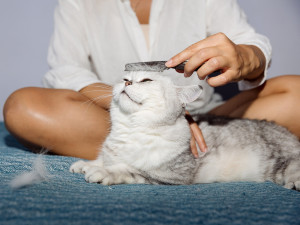Does My Pet Have Hay Fever?
Seasonal allergies can happen to your pet, too. They might just look a little different to yours
Thank goodness winter is over and the trees and flowers are budding. Unfortunately, with this change of season comes the dreaded hay fever. When you’re blowing your nose for the 1,000th time and surrounded by a mountain of tissues, have you ever wondered if your pet feels the same way?
Can dogs and cats get hay fever?
Yes! Surprisingly, dogs and cats can be affected by hay fever the same way us humans can. It can present a little differently, so let’s explore exactly what it looks like when our pets are affected and discover if there is anything we can do to help them out during allergy season.
Get (totally free) deals for food, treats, accessories, tech and way more pet parenting must-haves.
Just like us, our animals can be allergic to many things such as different foods or environmental causes and because the signs can be similar for each triggering allergen, it can be hard to find the source. Common environmental allergens are things like pollen from trees, flowers and grasses and other airborne causes like mould and mildew. Another notable source can be parasites (such as dust mites) along with severe reactions to flea salivaopens in new tab.
What are the symptoms?
When we think of hay fever, the symptoms we imagine are probably a lot of snot, a tickly nose, endless sneezes, itchy eyes and a sore red nose. Animals can get these symptoms, too, however it’s less common that their allergies manifest in this way, or to this extreme. They may have a runny nose and excess tears, but there are other clinical signs your pet may have allergies, the main one being something called ‘pruritus’, which means itchy skin.
Dogs and cats show pruritus in slightly different ways.
Dogs
Have you noticed your dog constantly sitting down to scratch, usually up around their collar or ears? Or have you clocked them rubbing their head furiously against anything they can; the sofa, the carpet or you? What about nibbling or biting constantly between their toes and at their back end? These are all classic signs your pup is itchy.
Sometimes the signs go a step further and physical changes can occur such as pink or orange staining of their fur around their feet, tummy and face. This is due to a type of yeast, called malassezia, which takes advantage of the situation by reproducing in excess due to the reduced skin barrier protection and over-licking. Your dog’s ears may go red and the skin there thickens, you can even sometimes smell the overgrowth of yeast. If this gets worse there can even be fur loss and sores can appear, which can lead to skin and ear infections.
Cats
Cats, on the other hand, show their itchiness by over-grooming. Their ears aren’t usually as affected as dogs and being such independent creatures, sometimes the only sign that they’re feeling itchy is something as extreme as fur loss or scabs near their ears or a few hairs out of place along their lower back (this is the site they usually scratch by licking and biting). While they don’t show as many signs as dogs, they are prone to causing damage to their skin by over-grooming, which can lead to large round patches of missing fur and sore skin that can get infected.
Some of these signs are so minor it is difficult to notice, but the sooner the signs are spotted the sooner we can break that itchy cycle and get our friends feeling better.
When is my pet most likely to suffer with hay fever?
Just like us, if your pet has an allergy to pollen from trees, grasses and other plants, the spring and summertime is when they are most affected. However, if their allergies are to other environmental causes such as dust mites, mould or flea saliva the effect can be year-round.
Does it matter if I’m in the country or the city?
Location can certainly have an effect on how bad your pet’s allergy is, especially if related to pollen. Out in the country, there are naturally more plants that produce pollen and so the triggering source is more likely to be around. However, it has been shown recently that trees in urban areas have higher pollen countsopens in new tab, so unfortunately being in a city won’t stop hay fever completely!
Is there anything I can do to prevent and treat hay fever symptoms in my pet?
There are lots of things we can do to help our pets out when allergies strike. Mainly, we want to limit the effect by reducing the triggering source as much as possible. This can mean wiping your dog’s paws after a walk, gently wiping their face and passing a damp towel over their body to remove as much pollen as possible.
Baths can work well, however, we want to help protect the skin barrier and cleaning too often can do the opposite and cause a thinning of that barrier, so stick to 2–3 times a week maximum. If you do need to bathe them, use gentle cleansers so as not to strip their natural oils and protection. Try picking soothing ingredients such as oatmeal, which can help calm the skin. If needed, try anti-fungal shampoos to help with any orange staining of their paws and fur.
With cats, this is a little trickier. Not many allow themselves to be bathed happily! You can however, try to wipe their faces and body if they allow it, but the most important thing you can do for your feline friends is make sure they are protected against parasites such as fleas and mites as this is a very common allergy in cats. Reducing the itchy triggers one by one means we can prevent the cycle of scratching and skin breakdown.
Treatments to stop the itching include antihistamines, steroid injections, oral medication or even monthly injections are available in some cases. If the scratching leads to infected skin or ears, pain medication and antibiotics may also be necessary. If the cause of the allergy is unknown it may be possible to get a blood test to check for different allergies, and immunotherapy treatment can be created based on your own pet’s individual results.
Are there holistic ways to treat my pet’s hay fever?
Unfortunately, there is not any current evidence on the reduction of hay fever after eating local honey, and while there are a lot of products targeting reducing itchiness in pets, it is best to check the ingredients with your vet to make sure they are safe before use. Instead, try to make sure your pet’s diet is full of things good for the skin to help promote a good skin barrier, this includes ingredients such as salmon oil, vitamin E and omega fatty acids.
When should I be worried about hay fever symptoms?
The sooner the itchy cycle is broken, the quicker the skin barrier can heal, so talk to your vet as soon as you notice more scratching than usual. These signs can be hard to spot however and symptoms can escalate quickly so if you notice patches of missing fur, inflamed ears, sore red skin or see any sign of pus then it’s best to get them checked out at the vet.
Allergies in pets can be a frustrating condition for both animal and owner as seasonal allergies are only one of many allergies our pets can have and sometimes the triggers are very difficult to find. The method of investigation is mostly a process of elimination and it can take months of exclusion diets and trials to locate the main issues. As with allergies in humans, it is best to view treatment as long-term management rather than cure, and treat each flare-up as they come.











